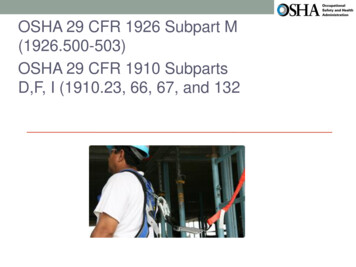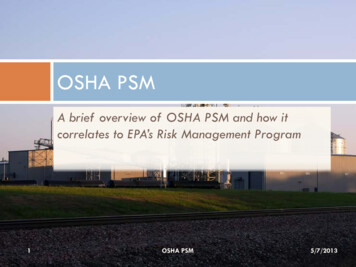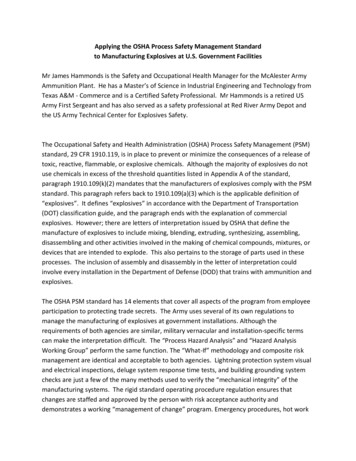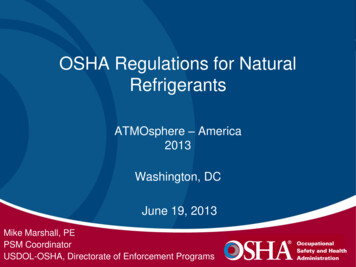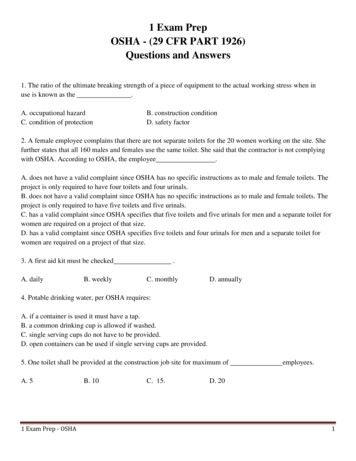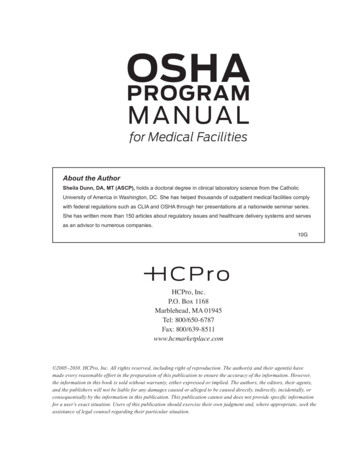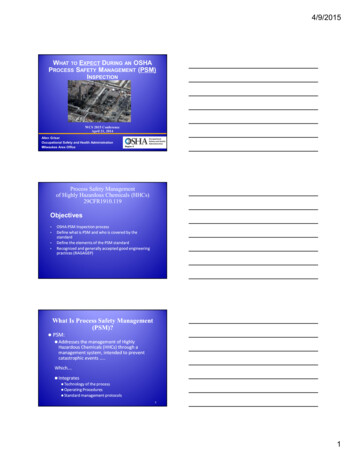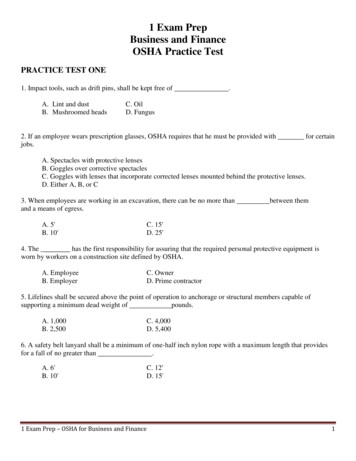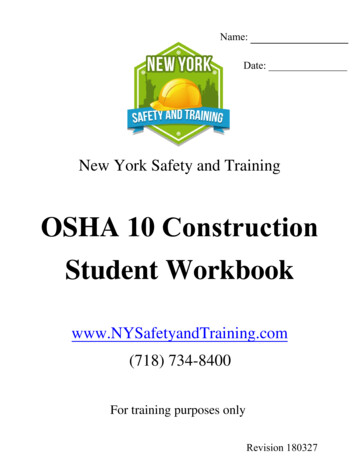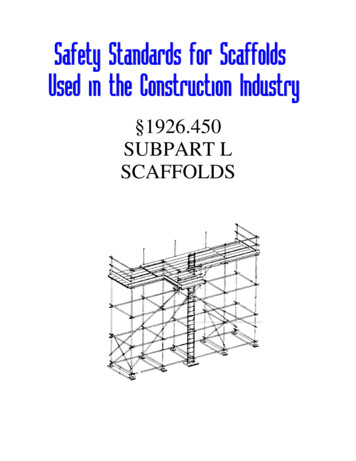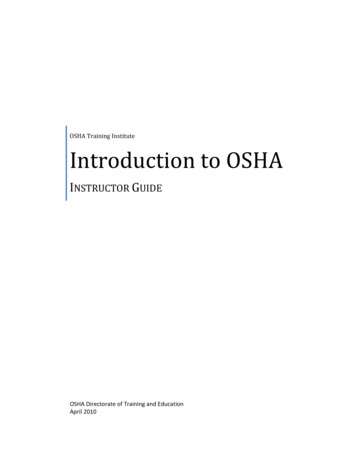
Transcription
OSHA Training InstituteIntroduction to OSHAINSTRUCTOR GUIDEOSHA Directorate of Training and EducationApril 2010
“Introduction to OSHA”2 HOUR LESSONTable of ContentsTRAINER PREPARATION GUIDANCE . iLesson Overview. 1Topic 1: Why is OSHA important to you? . 2A. History of OSHA . 3B. OSHA’s mission. 5C. Importance of this training . 6Topic 2. What rights do you have under OSHA? . 7A. Right to a safe & healthful workplace . 8B. Right to know about hazardous chemicals . 9C. Right to information about injuries and illnesses in your workplace. 10D. Right to complain or request hazard correction from your employer . 10E. Right to training. 11F. Right to hazardous exposure records and medical records . 11G. Right to file a complaint with OSHA . 12H. Right to participate in an OSHA inspection . 12I. Right to be free from retaliation for exercising safety and health rights. 13J. Worker responsibilities . 13Topic 3. What responsibilities does your employer have under OSHA? . 15A. Provide a workplace free from recognized hazards & comply with OSHA standards. 15B. Provide training required by OSHA standards . 16C. Keep records of injuries and illnesses. 19D. Provide medical exams and access to exposure and medical records . 21E. Not discriminate against workers who exercise their rights. 21F. Post OSHA citations and abatement verification notices . 22G. Provide and pay for PPE. 22Topic 4. What do the OSHA standards say? . 24A. Types of standards . 24B. How the standards are organized. 25Topic 5. How are OSHA inspections conducted? . 27A. Inspection priorities. 27B. Stages of an inspection . 29C. Citations and penalties . 31D. Appeals process . 33Topic 6. Where can you go for help? . 35A. Sources within the workplace/worksite. 35B. Sources outside the workplace/worksite . 37C. How to file an OSHA complaint . 39Session Summary . 42Conduct Test – Answer Key. 43References: . 44APPENDIX A: MSDS Explanation .A1APPENDIX B: Handout #12a, #12b, #12c Answer Sheet .B1APPENDIX C: Check Yourself Test Questions Answer Sheet . C1APPENDIX D: Check Yourself Test Questions Student Copy. D104.2010
“Introduction to OSHA”2 HOUR LESSON04.2010
“Introduction to OSHA”2 HOUR LESSONTRAINER PREPARATION GUIDANCEThe Introduction to OSHA lesson of the Outreach Training Program includes an instructor guide for thetrainer, a slide presentation, and student handouts. This lesson is for General Industry, Constructionand/or Maritime Industry training.Using the Instructor Guide (IG): The IG consists of instructions for trainer preparation, a detailed lessonplan, instructor references for student Handouts #3 and #12a, #12b, and #12c, along with test questionsand answers. The IG contains detailed content, activities, references and notes for the trainer. It is notintended to be a script that is read verbatim to the students. Rather, trainers should review theentire guide (including referenced materials and internet links) prior to conducting training, anduse it as a resource in their planning and presentation. The instructor presentation and preparationmaterials not included in this package may be downloaded from the OSHA website athttp://www.osha.gov. The OSHA standards may also be purchased from the Government Printing Office(GPO) Bookstore at http://bookstore.gpo.gov.The learning objectives: The Introduction to OSHA lesson was developed based on the terminal (TO)and enabling objectives (EO) below. These objectives are the expected student outcomes; therefore, thetrainer may not vary from these objectives when planning the training session.TO: Given OSHA historical events and current information, the student will be able to explain theimportance of OSHA in providing a safe and healthful workplace to workers covered by OSHA.Specifically, the student will be able to:EO 1: Explain why OSHA is important to workersEO 2: Explain worker rights under OSHAEO 3: Discuss employer responsibilities under OSHAEO 4: Discuss the use of OSHA standardsEO 5: Explain how OSHA inspections are conductedEO 6: Utilize helpful worker safety and health resourcesUsing the Slide Presentation: The Microsoft PowerPointTM 2003 file consists of 48 slides, which may beused by the trainer as a visual aid during the session. However, the focus of the training should be ondiscussion and interaction with the students, not on the PowerPointTM slides. The presentation wasdeveloped using Microsoft PowerPointTM 2003; therefore, it is compatible with this and higher versions ofthe product.Using the Student Handout Packet: The packet contains 12 numbered handouts representing 16 filesin the packet, since there are 3 versions (one for General Industry, one for Construction and one forMaritime) of 2 of the handouts (Handout #8, How to Read the OSHA Standards and Handout #12, Filingan OSHA Complaint). Along with your copy, copies of the Student Handout Packet should be made foreach student.An overview of the handouts and their use are tabled below. Step-by-step instructions are contained inthe IG in the Detailed Content and Notes sections of the lesson.Handout#1. Weekly Fatality/CatastropheReport#2. OSHA Poster#3. MSDS Example04.2010UseTopic 1: Use during the Fatality/Catastrophe Small GroupActivity. You may also download a Fatality/Catastrophe list ofweekly reports from the OSHA website.Topic 2: Discuss the worker rights included on the poster, as wellas additional worker rights.Topic 2: Conduct a group discussion on MSDSs and chemicalsused in the workplace. Appendix A, MSDS Explanation, may beused for instructor reference.Page i
“Introduction to OSHA”2 HOUR LESSONHandout#4. Your Rights as a WhistleblowerFact Sheet#5. Refusing to Work BecauseConditions are Dangerous#6. OSHA 300 Log example#7. Employers Must Provide andPay for PPE#8. How to Read the OSHAStandards: a. General Industry;b. Construction;c. Maritime Industry#9. Safety and Health Resources#10. Navigating the OSHAWebsite#11. Identifying Safety and HealthProblems in the Workplace#12. Filing an OSHA Complaintincludes tips for completion,scenario and form:a. General Industry*;b. Construction*;c. Maritime Industry*UseTopic 2: Highlight when covering the worker right to be free fromretaliation for exercising safety and health rights.Topic 2: Refer to when covering the worker right to refuse to do ajob if the worker believes in good faith that they are exposed toan imminent danger.Topic 3: Use when conducting the OSHA-300 Log ClassroomExercise.Topic 3: Discuss when covering the employer requirement toprovide and pay for PPE.Topic 4: Use when conducting the OSHA Standards ClassroomExercise. Select the version (a, b or c) which is appropriate foryour audience.Topic 6: Refer to when discussing safety and health resourcesoutside the workplace/worksite.Topic 6: Discuss when covering the OSHA website.Topic 6: Refer to when discussing filing a complaint to getworkplace hazards corrected.Topic 6: Highlight when conducting the Filing an OSHAComplaint Small Group Activity. Select the version (a, b or c)which is appropriate for your audience. Appendix B, Handout#12a, #12b, #12c Answer Sheet, may be used for instructorreference.*You may develop an alternate scenario for the activity covering filing a complaint (Handout #12a, #12b,or #12c). If so, the following information should be included: Company name, address and telephone number (and site information, if a different location) Management official in charge Type of business Description of the hazard or hazards, including location and number of workers exposed Whether the hazard has been brought to the attention of management or other governmentagencyFor the alternate scenario, you can use a situation with which you are familiar, or you can access OSHAaccident summaries for scenario ideas at: www.osha.gov/pls/imis/accidentsearch.htmlMedia and/or Teaching MethodsThe “Introduction to OSHA” 2-hour session has been set up as a facilitated, interactive training session.Students are given small “chunks” of information, and then are able to test their understanding of thesubject matter via activities and workshops. Several practice sessions included are designed to increasestudent awareness and enable them to apply what they have learned when they return to theirworkplaces.Ideal Setting or Conditions for the Training SessionThe ideal setting for this course is a classroom or other area where students have space to break intogroups.DisclaimerThis material is intended for training purposes only. Its purpose is to provide basic information aboutOSHA to workers and to inform workers of their rights under OSHA. This material is not a substitute forany provision of the Occupational Safety and Health Administration or any standards issued by OSHA.04.2010Page ii
“Introduction to OSHA”2 HOUR LESSONLesson OverviewThe purpose of this two-hour lesson is to provide workers with introductoryinformation about OSHA. This Instructor Guide is intended to be used whenpresenting General Industry, Construction, and/or Maritime Industry outreachcourses. The lesson is comprised of the following six topics:1. Why is OSHA important to you?2. What rights do you have under OSHA?3. What responsibilities does your employer have under OSHA?4. What do the OSHA standards say?5. How are OSHA inspections conducted?6. Where can you go for help?The lesson provides basic knowledge of: OSHA’s history and mission, worker rightsunder OSHA, employer responsibilities under OSHA, OSHA standards, OSHAinspections, and safety and health resources, including how to file an OSHA complaint.MaterialsNeeded:Listed inpresentation order Flip chart andmarkers Presentationslides Student handoutpackage OSH Act Copy of the OSHAStandards,General Industry,Construction, orMaritime Check YourselfTest Questions04.2010TrainingPreparation: All About OSHApublication Complaint scenario[Handouts #12a, #12b,and #12c] answers Cornell UniversityLibrary site on theTriangle Fire:http://www.ilr.cornell.edu/trianglefire/ MSDS explanation NIOSH website:http://cdc.gov/niosh OSHA website:http://www.osha.gov State Job Safety andHealth Programs FactSheet Training Requirementsin OS
Conduct Test – Answer Key.43 References:.44 APPENDIX A: MSDS Explanation .A1 APPENDIX B: Handout #12a, #12b, #12c Answer Sheet .B1 APPENDIX C: Check Yourself Test Questions Answer Sheet. C1 APPENDIX D: Check Yourself Test Questions Student Copy. D1 “Introduction to OSHA” 2 HOUR LESSON 04.2010 “Introduction to OSHA” 2 HOUR LESSON 04.2010 Page i TRAINER .
